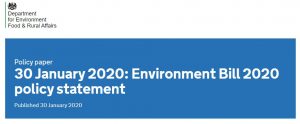The 30 January Environment Bill 2020 Policy Paper repeats the mantra of Theresa May’s ’25 Year Plan to Improve the Environment’ (2018) about having a metric to determine quite how biodiversity enhancement can be measured. The new Environment Bill 2020, through Michael Gove’s continuing encouragement ‘introduces a mandatory requirement for biodiversity net gain in the planning system, to ensure that new developments enhance biodiversity and create new green spaces for local communities to enjoy.’ England will benefit from the saving of £1.4 billion of ‘annual natural capital benefits’ representing ‘several thousands of hectare of habitat’ that will not now be lost! Ecosystems will benefit (e.g. air pollution, water flow control…) but they do not mention conservation of soils which is a significant issue in some protected areas such as AONBs. The bill states that the metric system will not undermine the existing range of protections that exists, not least of all ‘irreplaceable habitats’ and protected sites. That is fine then. ‘Conserve and enhance’ is fundamental to all UK conservation law, and it pops up again in the Environment Bill as ‘enhance and conserve biodiversity’ and helping to ‘deliver thriving natural spaces for communities.’ Communities is an issue that gets greater attention here. We are reminded that NERC (2006) originally set out a duty on public bodies to ‘have regard’ to conserving biodiversity, and the new bill seeks to strengthen LPAs in effecting ‘meaningful change.’ LPAs need to look out as they will have to return a ‘five-year report on the actions taken to comply with the new duty’ (surely updating the NERC 2006 duty of 14 years ago, if they have not done this already?). So two years in from the suggested biodiversity metric, we await much quantitative data proving that the loss of the natural capital has been halted. The Rt Hon Michael Gove would then be very pleased and offer us his big smile of success.

